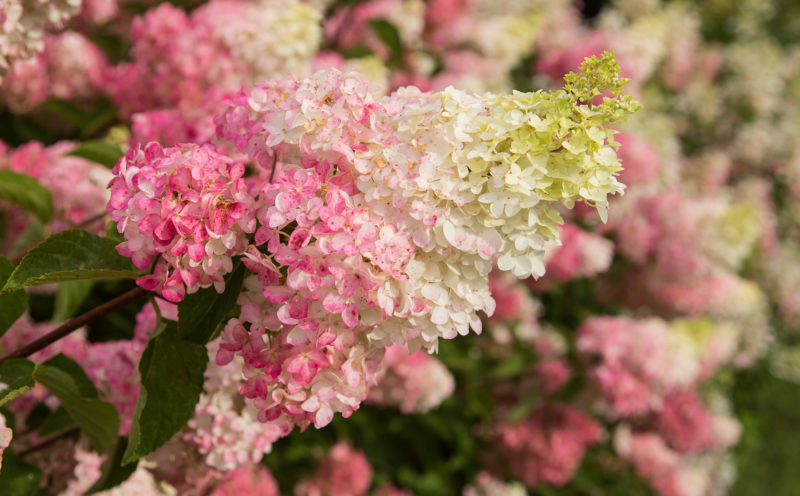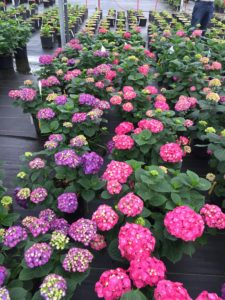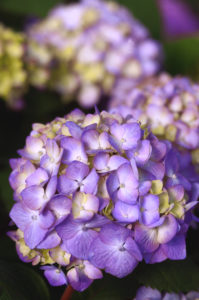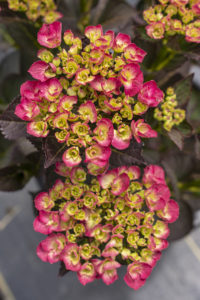
Celebrate Hydrangea!
Some might argue that hydrangeas should be recognized as plant of the century, rather than just the year 2020. Hydrangeas have been around forever, and most of us have fond memories of our parents or grandparents growing them. Today, there are so many to choose from — in various colors and textures, and for almost any application.
As we celebrate the Year of the Hydrangea, we picked the brains of some shrub experts to learn why they feel hydrangeas are trending and where the market is going from here.
GPN: Are you familiar with the National Garden Bureau’s “Year of” program? Do you take advantage of and promote the selected crops when they pertain to your business?
Alec Charais, Bailey Nurseries: Absolutely am! I vividly recall the “Year of” program early in my horticulture career when working at a retail garden center. It helped me as a young professional learn more about plants! We definitely take advantage of mentioning this to customers whenever possible.
Mike DuVall, Star Roses and Plants: Yes, I’m very familiar with the program. In 2017, we were thrilled to learn that it was the “Year of the Rose.” Because roses have been the key to our success for many decades, we were able to use NGB’s marketing tools and leverage their promotion of the “Year of” program.
Natalie Carmolli, Proven Winners ColorChoice Shrubs: Absolutely! Any time we can partner with an authority, like the National Garden Bureau, to promote our plants, we’d be silly not to take advantage of it! The “Year of” program is a great way to highlight our varieties to consumers in a very specific way.
GPN: 2020 has been named the “Year of the Hydrangea.” In your opinion, why do you think this crop was selected for the upcoming year?
Mike: Hydrangeas are widely recognized and widely loved by beginner gardeners and advanced gardeners. They are highly adaptable to a wide range of growing conditions and can be used in most areas of the country. From the rich blue and sometimes pink Hydrangea macrophylla to the lime-white paniculatas that grace many landscapes, hydrangeas are very accessible and offer a range of colors and textures to suit any style.
Natalie: Hydrangeas are one of North America’s most beloved garden plants. There is a wide number of varieties to choose from, they have year-long seasonal interest, and they are easy to grow. Plus, breeders are continuously making strides in hydrangea genetics, offering consumers more of what they love about this diverse genus, such as stronger stems, larger flowers, longer bloom time and increased hardiness.
Alec: There is so much happening in the hydrangea world. Incredible advancements in breeding have been made in the genus over the last 10 years. Additionally, the hunger for consumer use of hydrangeas in virtually every aspect of life, whether in the garden, use as décor, as cut flowers, in containers, at home, or in the office, has equaled or surpassed many other popular plants — including annuals!
Within industry walls some have stated that there are “too many” hydrangeas and that the market is flooded, but the fact is, consumers are just getting started enjoying these diverse and beautiful cultivars and the genetics continue to get better and better.
GPN: What has been your role and experience in the development, marketing and/or sale of hydrangea?

Natalie: I’d be lying if I didn’t say the hydrangea market is a crowded one, but there is always room for improvement. Our breeders work hard to be sure they are introducing new hydrangeas that will give consumers greater success, and satisfaction, in their gardens. It’s our job as marketers to create awareness of not only the availability of new cultivars, but to let consumers know why a new cultivar may be preferable over an older one and how they can use hydrangeas in their landscapes and gardens.
We’ve also worked really hard to help home gardeners understand that “hydrangea” doesn’t just mean one plant — that there are six different types/species of hydrangeas that are grown in North American gardens, and that some are more suitable to certain climates than others. We call this approach “Hydrangeas Demystified” and it has done a lot to help people select the right hydrangea for their home and finally achieve the success they’ve yearned for.
Mike: I’ve been in the industry for 35 years and have worked with breeders and growers throughout the country. In my former role as a senior merchant of live goods at Home Depot, I gained valuable retail perspective. I’ve also had the honor and opportunity to study under Dr. Michael Dirr, the foremost expert on hydrangeas. Woody ornamental plants are a lifelong passion for me, so, for many years I’ve been involved in selecting hydrangeas for introduction.
Alec: Bailey has a long-standing commitment to leading the way in hydrangeas. As stewards of the Endless Summer brand, along with First Editions, which includes a number of exceptional Hydrangea paniculata varieties, Bailey’s product development team works daily on breeding and selecting the very best genetics for the marketplace. Furthermore, we travel extensively to learn about and share information with other industry professionals working with this important crop.

Personally, before entering the role of marketing and communications manager, I traveled the Twin Cities region as a territory sales representative at the beginning of the Endless Summer phenomenon in the early 2000s. Plant marketing, and especially branding, within horticulture was an extremely new concept. Endless Summer served as a model for what could be accomplished through a dynamic marketing campaign that not only reached the consumer, but included the retailer so that pull through demand was created.
Consumer and industry needs haven’t changed that much since the early Endless Summer days. What has changed significantly are the mediums in which marketers deliver that message. Digital platforms have evolved from websites to social media, paid and organic search, and new mediums such as subscription television, allowing sellers to target potential customers.
GPN: What changes and innovations have you seen in recent years in the hydrangea category?
Mike: There have been many changes and innovations in the hydrangea category, including longer bloom periods, better re-blooming characteristics, more compact habits, flower size, changing flower colors during the season, fall foliage color, sturdier stems for less flop and increased cold hardiness.
Alec: In the beginning, the partnership between Bailey and Dr. Michael Dirr paved the way for Endless Summer and its remontant Hydrangea macrophylla varieties. In recent years, Bailey has solidified itself as a leading breeder with investments in a professional breeding program in Athens, Georgia, named Bailey Innovations. The main breeding focus at Bailey Innovations is H. macrophylla, but the program encompasses other hydrangea species as well as other genera. Over the years, the advancements in flower power, plant habit, heat tolerance and different flower types has really shown us that the hydrangea market and the opportunities to bring unique plants that perform for the consumer — whether it be a homeowner or a landscape pro — are full of potential.
It’s also exciting is to see growth in hydrangea species outside of H. macrophylla. There are some incredible varieties on the market today. ‘Limelight’ from Spring Meadow was a game changer for this category. Since then, they’ve brought additional varieties like ‘Little Lime’, ‘Bobo’ and ‘Little Quick Fire’ to market. Bailey has also introduced a number of exceptional paniculata hydrangeas in the First Editions brand. ‘Vanilla Strawberry’ is a beautiful, large-flowered white that turns strawberry red and white when the night temperatures cool. Recently, ‘Berry White’ is a real WOW because its similar color and strong stems make it fantastic in the landscape and for cuts.
Natalie: The answer to this varies depending on the species of hydrangea — each one presents different opportunities for improvement and innovation. For example, among Hydrangea arborescens, Tom Ranney and his team at North Carolina State University have developed new flower colors (pink, purple/mauve, lime), dwarf habits and strong, sturdy stems that prevent the flopping that has always plagued ‘Annabelle’, projects which have been 20 years in the making. Improvements for Hydrangea paniculata are geared toward earlier bloom times — an innovation that benefits both the industry and the consumer — and better flower color development.
In the realm of Hydrangea macrophylla, we’ve worked to improve cold climate performance with improved flower bud hardiness, and a shorter time to rebloom (i.e., reducing the period required for a plant to form new wood flower buds). Tim Wood, our new plant development manager, selects H. macrophylla that have the unique quality of setting flower buds lower down on the stems instead of merely at the terminal buds. Using such plants in our breeding program enhances reliability in cold climates and creates an even more dramatic display in milder areas.
GPN: How can growers capitalize on hydrangea?
Alec: Demand from retailers and consumers is widespread so the heavy lifting in this established category is done. Based on the growers we work with, the key to capitalizing on that demand is selecting varieties and brands that have effective marketing support behind them and growing great quality plants. As we all know, if a plant looks good on the retail bench and is in a nice package, it sells quickly. The other thing to consider is the importance of plants in bloom. Well-grown, blooming hydrangeas in the garden center fly out the door. The other opportunity is for color growers. While hydrangea has traditionally been grown by woody plant nurseries, there’s potential for color growers looking for shoulder season crops to add to their offering. We are working with several color growers on production schedules and liner types to streamline the process.
Mike: Growers should incorporate newer, improved varieties in their production mix. A well-grown, high-quality hydrangea will stand out at retail. They should have large quantities of just a few varieties. Not having 10 different varieties on the hydrangea table at retail helps to simplify the purchasing decision for shoppers.
Natalie: We believe that sales success comes with strong support. At Proven Winners ColorChoice, we have many new hydrangeas coming to market in the next few years. In order to make sure our growers are successful with these new varieties, we offer many resources, like grower sheets and spec sheets. Benchcards and copies of our retail tags are also available, creating a complete suite to help everyone in the supply chain understand what the plant looks like, what it does differently than others, and what the presentation to consumers will look like.
Also, growers should be sure they are carrying the newest genetics. Those plants are bred to be stronger and have better container presentation, which means bigger blooms and longer bloom time. Encouraging nurseries to feature hydrangeas using POP opportunities like Proven Winners destinations (www.provenwinners.com/destination) is also a great way to ensure they make the most of the Year of the Hydrangea.
GPN: What are some new/unique/special recent hydrangea introductions? What are their characteristics?

Mike: We are introducing a hydrangea this year that is very unique. ‘Akadama’ is unlike any hydrangea on the market. It offers a stunning red flower color that experiences amazing color changes with the seasons, including exceptional fall interest. With a longer bloom period, a compact habit, sturdier stems and a tinge of burgundy in the foliage, ‘Akadama’ is a game-changer in the world of hydrangeas.
Another variety that we recently introduced is ‘Double Down’ hydrangea, which is the strongest re-blooming Hydrangea macrophylla on the market. Fully double, mophead flowers are light pink, star-shaped and gain shades of green as they age. ‘Double Down’ is extremely floriferous with a compact habit and sturdy stems that make it a must for any retailer.
Natalie: We have added two hydrangeas to our Let’s Dance series of reblooming hydrangeas. The first is ‘Let’s Dance Big Band’ Hydrangea macrophylla. With extra-large inflorescences and excellent rebloom, and the ability to create new wood flower buds more rapidly than other macs, it is one of the most foolproof big-leaf hydrangeas you can grow. In that same series is the lacecap ‘Let’s Dance Cancan’ Hydrangea serrata. It is also an excellent rebloomer, requiring only a short period of vegetative growth in order to create new wood blooms. However, it has another trick up its sleeve: it sets its flower buds on terminal buds as well as buds lower on the stems, which means that if it is cut back, or damaged by cold temperatures, those lower old wood buds will still develop into flowers. It’s a huge leap forward in achieving success with hydrangeas.
Alec: Wow, this is a hard question to answer. Had I been asked this question a couple of years ago, without hesitation I would have answered Endless Summer ‘BloomStruck’. ‘BloomStruck’ represents the improvements in breeding we can all get excited about. In addition to its rich, violet blooms in acidic soils, it has fantastic rebloom capability compared to its ancestor, Endless Summer ‘The Original’. It’s why we continue to be excited about the breeding work that is hitting the market today. The improvements mean success for consumers in warmer climates that struggle with hydrangeas in the summer because of its exceptional heat tolerance.
I am also a big fan of H. arborescens ‘Invincibelle Ruby’. For those of us in the North, good ol’ ‘Annabelle’ has been a mainstay — and for good reason. When I saw ‘Invincibelle Ruby’ on display in the landscape in Dale Deppe’s yard a few years ago en masse with its nice, compact habit and rich pink blooms, I knew it would be an opportunity to give northern gardeners a nice option to the traditional white flowered smooth hydrangeas.
How much time do we have? Because I could keep going! I really like ‘Strawberry Sundae’, a lovely compact pink-flowering paniculata that blooms earlier than the species. For those who love oak-leaved hydrangeas that haven’t tried ‘Jetstream’, they are missing out on this compact variety.
And my bias wouldn’t be complete without mentioning what I believe is the best H. macrophylla today – Endless Summer’s ‘Summer Crush’. With blooms that are rich, raspberry-red color, tremendous rebloom, exceptional heat tolerance, and compact habit, ‘Summer Crush’ has shown itself to be great not only in the landscape, but because of its habit it rivals nearly any annual in decorative containers and hanging baskets. Yes, you heard me — hanging baskets!
GPN: Is there anything in the pipeline in the hydrangea category that you can share?
Mike: We have a lot of trial and evaluations going on across multiple species that look very promising. Our breeding objectives and partnerships with leading Hydrangea experts around the world will certainly produce improved and unique selections. All of these varieties will be selected with performance for the homeowner, grower and retailer in mind.
Alec: In terms of H. macrophylla, we are breeding in distinct categories including doubles, bi-colors, unusual foliage colors, improved whites, very compact selections, deep sepal colors and more. In terms of H. paniculata, earliness to flower and heat tolerance are focal points.
Natalie: Our hydrangea breeding program is extensive, and we have literally thousands of varieties under evaluation each year. While we of course have specific breeding goals in mind for each species, we’re also looking for anything new and surprising. There have been so many breeding advancements that the bar truly is high for a plant to be worth introducing: it can’t be something as simple as, “oh, this one is a more vibrant shade of pink.” New introductions have to be truly better, with a demonstrated ability to outperform its brethren in at least one way. So one way to do that is to create new niches, for example, select for compactness, disease resistance, and extended bloom times (both early and late).
GPN: What makes hydrangea especially appealing to consumers?
Natalie: It seems like hydrangeas have been around forever, so they have a huge nostalgia appeal — the whole, “My grandfather grew the most beautiful hydrangeas!” thing, and wanting to recreate that experience at home. It’s also worth noting that simply their big, showy shrubs offer lots of bang for the buck, and for the effort. When the correct plant is chosen and sited, they can be virtually maintenance free. Blooms can be cut for floral displays in the summer and dried for use all season long. And advances in breeding to introduce plants that are more compact make it easier than ever to incorporate hydrangeas in small or existing garden spaces.
Alec: More and more consumers are drawn to high-impact flowering plants that come back year after year. The hydrangea species mentioned earlier fit that bill perfectly. On top of that, they can be used in deco pots on the patio or balcony, are wonderful as cut flowers for the home, and last, but not least, we always hear from consumers that have an emotional connection to hydrangeas. In some cases, someone in their family may have had hydrangeas on their property or it was a favorite flower of someone close to them. Hydrangeas are truly the belle of the ball when it comes to flowering shrubs.
Mike: Hydrangeas shine in the garden and when used as a cut flower. With the trend of farm-to-table flowers still on the rise, home gardeners want a simple way to bring flowers inside, and hydrangeas do just that. Additionally, hydrangeas span many generations. Baby Boomers and millennials alike enjoy the low-maintenance garden structure and beautiful flowers that hydrangeas offer. Because they work in multiple geographical
areas, offer a long bloom period, provide season-long color, and are easy to grow, it’s understandable that hydrangeas are appealing to consumers and that NGB has declared 2020 the “Year of the Hydrangea!”


 Video Library
Video Library 




















